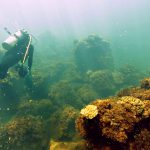Atlas to help advance innovations in agriculture, energy, health
The planet is home to a vast number of microscopic living organisms – plants, animals, and bacteria – found from deep sea volcanoes to the highest mountain peaks. These organisms too small to be seen by the naked eye affect both human health and the health of the world’s ecosystems. Despite their centrality to life on Earth, scientists have a limited understanding of their fundamental structure.
In an effort to better understand these communities or ‘microbiomes,’ scientists from NOAA’s Atlantic Oceanographic and Meteorological Laboratory (AOML) took part in a massive global research collaboration known as the Earth Microbiome Project (EMP), which recently released the first reference database, or atlas, of microbes covering the planet. This guide, released online in Nature today, will allow scientists to collaborate on studies and catalogue microbial diversity at an unprecedented scale.
“Microbes are everywhere,” said first author Luke Thompson, Ph.D., project manager and current research associate at NOAA. “Yet prior to this massive undertaking, changes in microbial community composition were identified mainly by focusing on one sample type, one region at a time. This made it difficult to identify patterns across environments and geography to infer generalized principles.”

Researcher sampling the southern most geothermal soils on the planet at the summit of Mt Erebus, Ross Island, Antarctica. Image credit: University of Waikato, New Zealand

Researcher sampling the southern most geothermal soils on the planet at the summit of Mt Erebus, Ross Island, Antarctica. Image credit: University of Waikato, New Zealand
In the new research, project members analyze bacterial diversity among various environments, geographies and chemistries by sequencing the 16S rRNA gene, a genetic marker specific for bacteria and their relatives, archaea. The 16S rRNA sequences serve as “barcodes” to identify different types of bacteria, allowing researchers to track them across samples from around the world. Researchers also used a new method to remove sequencing errors in the data, allowing them to get a more accurate picture of the number of unique sequences in the microbiomes.
Further understanding of microbial communities could transform our understanding of the world and help launch innovations in agriculture, energy, health, the environment, and more. This new database could help open doors to a number of microbiome-based treatments for human health ailments, while the impacts of ocean and soil microbes on atmospheric carbon dioxide are critical for understanding climate change.

Researchers take seawater samples at their monitoring site in the English Channel. Image credit: Plymouth Marine Laboratory
“The potential applications for this database and the types of research questions we can now ask are almost limitless,” said Rob Knight, one of the founders of the EMP, professor and director of the Center for Microbiome Innovation at University of California San Diego. “We can now identify what kind of environment a sample came from in more than 90 percent of cases, just by knowing its microbiome, or the types and relative quantities of microbes living in it. That could be useful forensic information at a crime scene… think ‘CSI.’”
The goal of the Earth Microbiome Project is to sample as many of the Earth’s microbial communities as possible to advance scientific understanding of microbes and their relationships with their environments, including plants, animals and humans. So far, the project has spanned seven continents and 43 countries, from the Arctic to the Antarctic, and more than 500 researchers have contributed to the sample and data collection. Project members are using this information as part of approximately 100 studies, half of which have been published in peer-reviewed journals.

Infographic: Earth Microbiome Project by the numbers. Image credit: UCSD Center for Microbiome Innovation
View the official Earth Microbiome Project press release here..
Originally Published November 2017 by Sierra Sarkis








